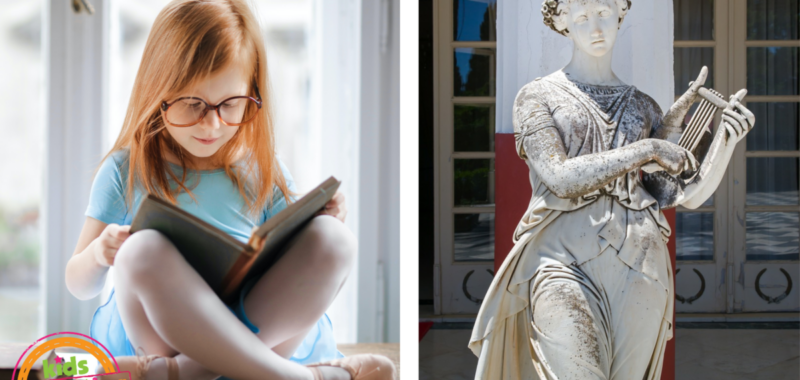Come read and learn about the Nine Muses from Greek mythology! Today we’ll be exploring these goddesses of the arts and sciences, and how important they were to the ancient Greeks! Learning about these goddesses will be great for any kids who are interested in mythology, the arts, sciences, and history! You can read about the Nine Muses in the classroom, as an at home lesson, or bedtime story!

Ancient greece and the nine muses
Although the Nine Muses are not usually mentioned in Greek mythology, they were still an integral part of Ancient Greek culture and religion. The muses were thought to be some of the most important goddesses due to their ability to inspire writers, poets, artists, historians, and scientists alike.
The nine muses were thought to be the daughters of Zeus, the king of the Greek gods, and Mnemosyne, the goddess of memory. Due to their parents, the muses were thought to be the preservers of memory in addition to their role as goddesses of the arts and sciences. They were also thought to aid against forgetfulness!

In addition to this, the nine muses were often depicted with Apollo, the Greek god of the sun, the arts, music, poetry, and many other things. They are written to be his attendants in some versions of Greek myth as well. Their proximity to Apollo, a god who was widely worshipped and was seen as highly important to the Greeks, furthers the nine muses influence on Ancient Greek culture and society.
who are the nine muses?
The Nine Muses were nine goddesses who represented the arts and sciences. Here is a list of each muse and what she was the goddess of!

1. Kalliope (Calliope)
Kalliope was the muse of epic poetry, which included works like the Iliad and the Odyssey. She was also regarded as the leader of the muses.
Kalliope is also the mother to the Greek hero, Orpheus who was known for his beautiful music and trip to the underworld to try to save his lover, Eurydice.
2. Kleio (Clio)
Kleio (pronounced “Cleo”) was the muse of history. She is usually depicted holding a scroll or beside a pile of books.
Her name comes from the Greek word kleô which means “to celebrate.”
3. Ourania (Urania)
Ourania is the muse of astronomy. She is usually depicted holding a globe or studying a globe.
4. Thaleia (Thalia)
Thaleia is the muse of comedic theater. Comedic theater is the genre of Greek theater that features happy or funny subject matter. She is usually paired with the muse Melpomene. Thaleia is also typically shown holding a smiling theater mask.
5. Melpomene
Melpomene is the muse of tragic theater. Tragic theater is the genre of Greek theater that features sad subject matter. Melpomene is usually shown alongside Thaleia, and she is holding a frowning theater mask.
6. Polymnia (Polyhymnia)
Polymnia is the muse of religious hymns. She is usually shown to be in meditative pose.
7. Erato
Erato is the muse of love poetry.
8. Euterpe
Euterpe is the muse of lyric poetry.
9.Terpsikhore (Terpsichore)
Terpsikhore is the muse of choirs, background or choral singing, and choral dance.
Fun and educational video about the muses
Come watch this educational video about the Nine Muses from Greek mythology by the World History Encyclopedia. Learn some cool fun facts and history by watching the video!
More history Fun and ACTIVITIES from kids ACTIVITIES blog
Which was your favorite Muse? Let us know in the comments below!
Sources
Encyclopædia Britannica, inc. (n.d.). Muse. Encyclopædia Britannica. www.britannica.com/topic/Muse-Greek-mythology
Kleio. CLIO (Kleio) – Greek Goddess Muse of History. (n.d.). https://www.theoi.com/Ouranios/MousaKleio.html
Mousai. MUSES (Mousai) – Greek Goddesses of Music, Poetry & the Arts. (n.d.-b). www.theoi.com/Ouranios/Mousai.html
Polymnia. POLYHYMNIA (Polymnia) – Greek Goddess Muse of Hymns. (n.d.). https://www.theoi.com/Ouranios/MousaPolyhymnia.html
World History Encyclopedia. (2022, November 21). Who are the nine muses of greek mythology?. YouTube. www.youtube.com/watch?v=KnWWL9Ve3_M

